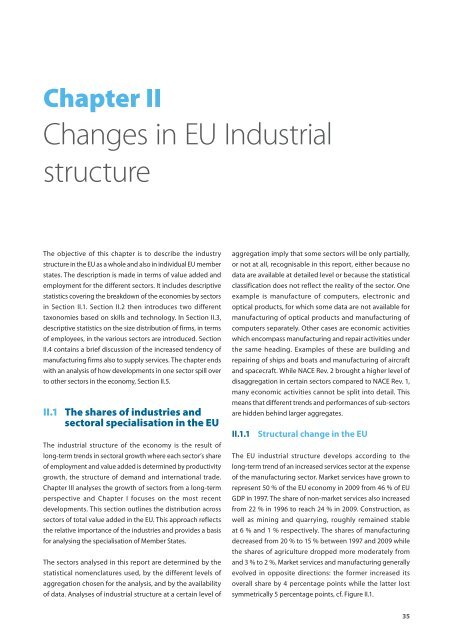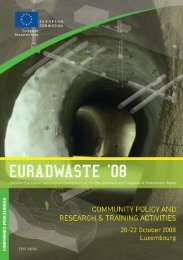EU industrial structure - EU Bookshop - Europa
EU industrial structure - EU Bookshop - Europa
EU industrial structure - EU Bookshop - Europa
Create successful ePaper yourself
Turn your PDF publications into a flip-book with our unique Google optimized e-Paper software.
Chapter II<br />
Changes in <strong>EU</strong> Industrial<br />
<strong>structure</strong><br />
The objective of this chapter is to describe the industry<br />
<strong>structure</strong> in the <strong>EU</strong> as a whole and also in individual <strong>EU</strong> member<br />
states. The description is made in terms of value added and<br />
employment for the different sectors. It includes descriptive<br />
statistics covering the breakdown of the economies by sectors<br />
in Section II.1. Section II.2 then introduces two different<br />
taxonomies based on skills and technology. In Section II.3,<br />
descriptive statistics on the size distribution of firms, in terms<br />
of employees, in the various sectors are introduced. Section<br />
II.4 contains a brief discussion of the increased tendency of<br />
manufacturing firms also to supply services. The chapter ends<br />
with an analysis of how developments in one sector spill over<br />
to other sectors in the economy, Section II.5.<br />
II.1 The shares of industries and<br />
sectoral specialisation in the <strong>EU</strong><br />
The <strong>industrial</strong> <strong>structure</strong> of the economy is the result of<br />
long‑term trends in sectoral growth where each sector’s share<br />
of employment and value added is determined by productivity<br />
growth, the <strong>structure</strong> of demand and international trade.<br />
Chapter III analyses the growth of sectors from a long‑term<br />
perspective and Chapter I focuses on the most recent<br />
developments. This section outlines the distribution across<br />
sectors of total value added in the <strong>EU</strong>. This approach reflects<br />
the relative importance of the industries and provides a basis<br />
for analysing the specialisation of Member States.<br />
The sectors analysed in this report are determined by the<br />
statistical nomenclatures used, by the different levels of<br />
aggregation chosen for the analysis, and by the availability<br />
of data. Analyses of <strong>industrial</strong> <strong>structure</strong> at a certain level of<br />
aggregation imply that some sectors will be only partially,<br />
or not at all, recognisable in this report, either because no<br />
data are available at detailed level or because the statistical<br />
classification does not reflect the reality of the sector. One<br />
example is manufacture of computers, electronic and<br />
optical products, for which some data are not available for<br />
manufacturing of optical products and manufacturing of<br />
computers separately. Other cases are economic activities<br />
which encompass manufacturing and repair activities under<br />
the same heading. Examples of these are building and<br />
repairing of ships and boats and manufacturing of aircraft<br />
and spacecraft. While NACE Rev. 2 brought a higher level of<br />
disaggregation in certain sectors compared to NACE Rev. 1,<br />
many economic activities cannot be split into detail. This<br />
means that different trends and performances of sub‑sectors<br />
are hidden behind larger aggregates.<br />
ii11 structural change in the Eu<br />
The <strong>EU</strong> <strong>industrial</strong> <strong>structure</strong> develops according to the<br />
long‑term trend of an increased services sector at the expense<br />
of the manufacturing sector. Market services have grown to<br />
represent 50 % of the <strong>EU</strong> economy in 2009 from 46 % of <strong>EU</strong><br />
GDP in 1997. The share of non‑market services also increased<br />
from 22 % in 1996 to reach 24 % in 2009. Construction, as<br />
well as mining and quarrying, roughly remained stable<br />
at 6 % and 1 % respectively. The shares of manufacturing<br />
decreased from 20 % to 15 % between 1997 and 2009 while<br />
the shares of agriculture dropped more moderately from<br />
and 3 % to 2 %. Market services and manufacturing generally<br />
evolved in opposite directions: the former increased its<br />
overall share by 4 percentage points while the latter lost<br />
symmetrically 5 percentage points, cf. Figure II.1.<br />
35
















